
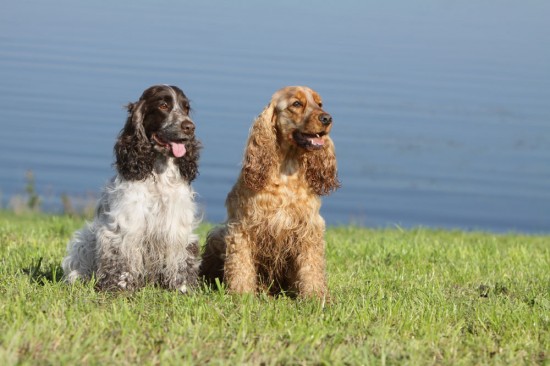
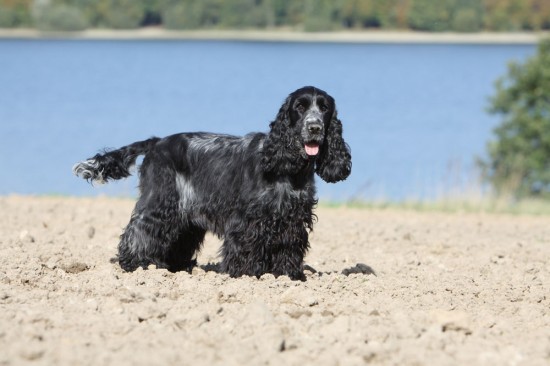
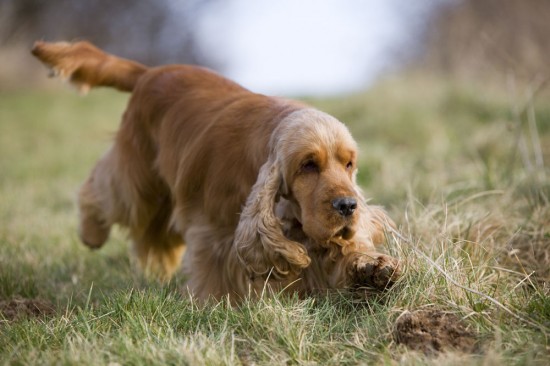

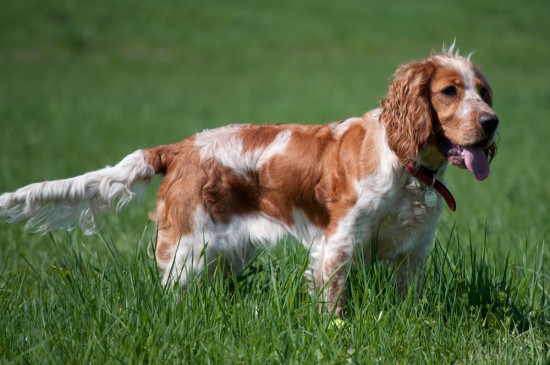
One of the most recognisable breeds, the Cocker Spaniel is a popular dog and makes a very good pet for an active family. One of the ‘flushing’ breeds, the working Cocker is used for searching in undergrowth for game birds, causing them to fly up for the gun. In fact the name ‘Cocker’ is taken from the Woodcock that they would flush extensively in the past. Even if you have the show type Cocker this trait will become evident when you walk your dog in the woodland; he will spend all his time sniffing and crashing through the undergrowth trying to find something to flush. So driven by smell is he that it is cruel not to allow your Cocker access to the countryside as that is where he is happiest; country smells should not be denied him.
Together with the English Springer Spaniel, the Cocker was originally known as part of a group called Land Spaniels but it soon became recognised that the smaller dogs were more able to push into very dense thickets and hedgerows. To maintain this advantage some breeders started to intentionally produce these smaller Spaniels until eventually, in 1893, the Land Spaniels became two distinct groups: Cocker’s and Springer’s.
More recently the Cocker was again split into two different groups, the American and the English, with the American Cocker Spaniel being slightly smaller than the English Cocker. And it doesn’t end there, for the English Cocker breed has been split into the working type and the show type with both being readily available throughout the UK.
Should you choose the working Cocker as your companion you need to be very careful; be prepared for him to be extremely energetic and always busy which of course means that he will require lots of exercise and stimulation. However working Cocker’s still make great pets as long as you are aware of, and fulfil, all his needs. Working Cocker’s are not just used for flushing game; they are also used in the armed services, search and rescue, the police force, and to assist with pest control.
Another thing to be considered if you decide on a working Cocker is the fact that he may have had his tail docked. If you do not intend to work him, and let’s face it there aren’t that many people these days who have a genuine working dog, don’t buy a puppy with a docked tail. No longer allowed just for aesthetic reasons, docking is a practise that is no longer generally acceptable and indeed the procedure may also have been unlawful. Cutting down the tail by one half to a third supposedly helps to prevent injury to a working dog as he runs through heavy foliage flushing game. Unfortunately there are still some unscrupulous people who will dock tails even if the puppy is not destined to become a genuine worker. If you really do need a working dog and buy a puppy with a docked tail you must make sure that it has been docked legally and correctly by an experienced and authorised person as mistakes are often made including cutting the tail too short resulting in a stump that won’t heal properly. Although tail docking of non working dogs has been banned in England since 2007, people are still finding ways to get around the law so to ensure that the puppy you choose as a genuine worker has undergone legal docking of his tail, he should come to you with a certificate issued and signed by a vet which must also contain certain information.
As well as being potentially cruel, docking of the tail can also affect your Cocker’s balance and gait as well as causing behavioural problems. The lack of a tail can easily cause a dog’s intentions to be misinterpreted by another canine. Using the tail as a flag and waving it gently when meeting another dog gives out a message of peace; your dog is saying ‘I don’t want trouble’. If your dog hasn’t got a tail to signal with, his intentions may be misinterpreted and the other dog may attack leading to future problems with canine socialisation.
Having had two Cocker’s, one with a docked tail and one without, I can honestly say that there is nothing as fine as a lovely, long, feathered, wagging tail, and, in my eyes at least, a Cocker with a docked tail no longer looks right.
The show type Cocker should never have a docked tail. Show type Cocker’s are probably more common than working; always anxious to please as well as being gentle, playful, friendly, and affectionate he will soon become devoted to you. Highly intelligent and curious, tireless and energetic, the Cocker Spaniel is often described as ‘merry’ and with his happy demeanour and an almost permanently wagging tail he is a delight. Whilst he can sometimes be stubborn he is relatively easy to train and will remain loyal.
Available in many colours, the show type Cocker most commonly has a coat colour of solid gold; solid red; solid black; black and tan; blue roan; black and white ticked; or liver and tan. The working Cocker also has many coat colours, some of them the same as the show type.
So remember – a show type Cocker will always have a full tail; a working type Cocker does not have to have a docked tail! Also don’t even consider having a Cocker Spaniel unless you can provide access to the countryside and like country walks.
As always, and I make no apology for repeating this time and time again, ensure that you get your puppy from a reputable breeder. Make sure you avoid retail outlets which almost always deal in puppies from puppy farms with all the problems that entails. When you view your puppy he should always be seen with his mother and never agree to have a puppy delivered to you – always go to the breeder’s home.
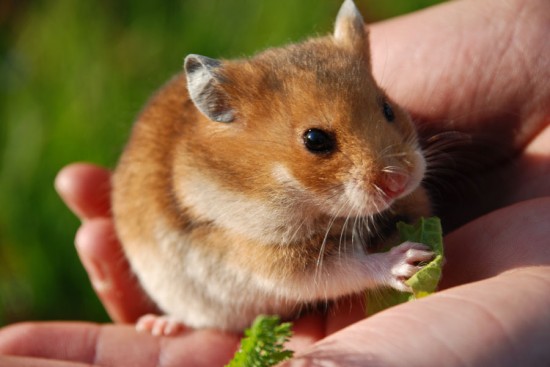 Guide To Keeping Hamsters
Guide To Keeping
Guide To Keeping Hamsters
Guide To Keeping
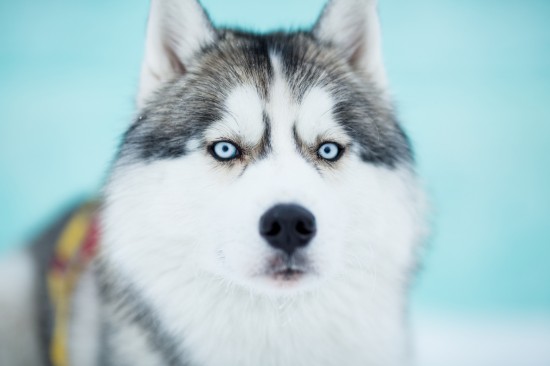 How Closely Related Are The Siberian Husky And The Wolf?
How Closely Relat
How Closely Related Are The Siberian Husky And The Wolf?
How Closely Relat
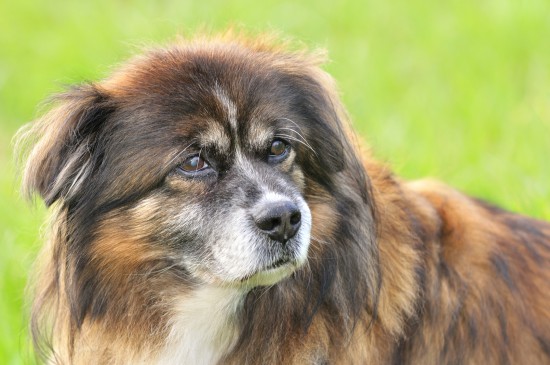 How To Estimate The Age Of A Dog With An Unknown History
How To Estimate T
How To Estimate The Age Of A Dog With An Unknown History
How To Estimate T
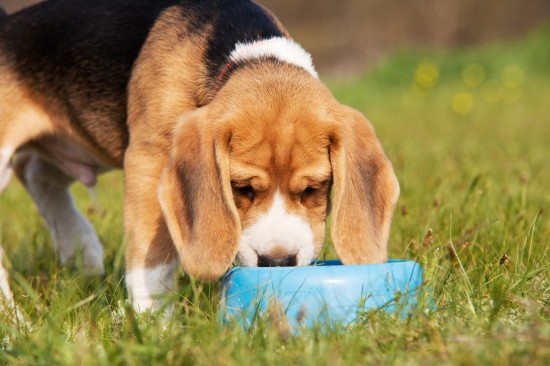 Ten Golden Rules To Follow When Feeding Your Dog
Ten Golden Rules
Ten Golden Rules To Follow When Feeding Your Dog
Ten Golden Rules
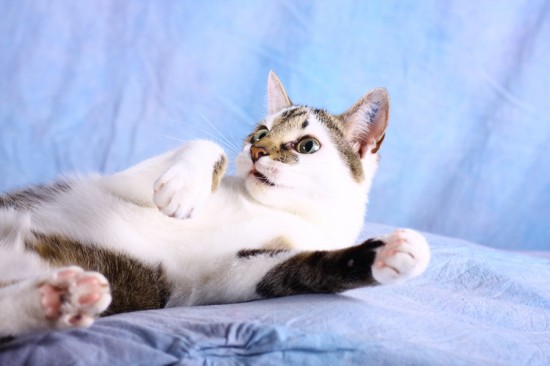 Cat Behaviour Explained
Cat Behaviour Exp
Cat Behaviour Explained
Cat Behaviour Exp
Copyright © 2005-2016 Pet Information All Rights Reserved
Contact us: www162date@outlook.com